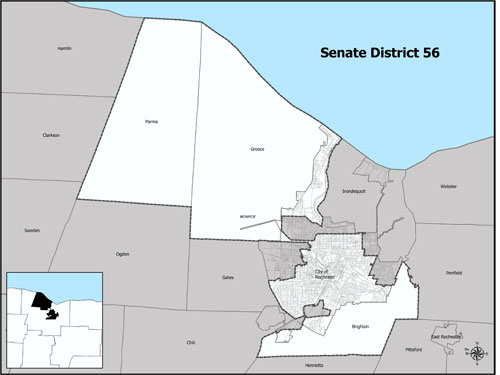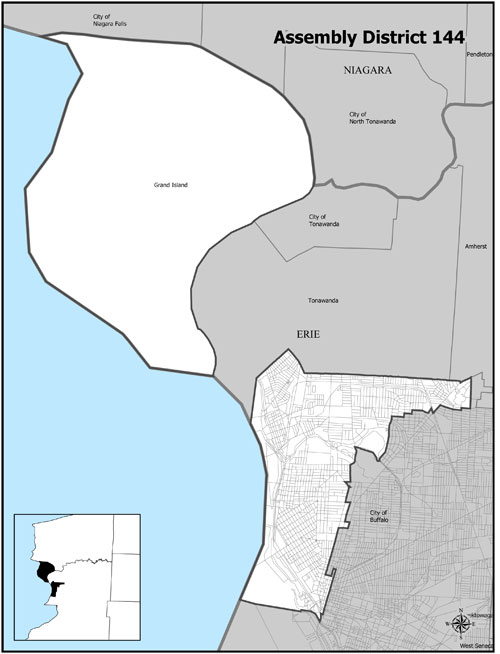Some of New York's districts look less like Congressional and legislative boundaries and more like Rorschach tests.
Take, for example, Senate District 56: Two masses, encompassing Parma, Greece and parts of Irondequoit to the left and parts of Rochester and Brighton on the right, are connected by a teeny strip of land that could possibly be made of two or three streets.

Then there's Assembly District 144, comprised of the town of Grand Island and a part of Buffalo -- which aren't touching at all.

These are just two examples of complex puzzle pieces that are New York's Congressional and legislative districts.
Of course, some odd lines and angles have to be drawn to comply with the Voting Right Act -- guaranteeing that minority groups have representation -- or to ensure that there are a comparable amount of people in each district.
The rest, however, is at the liberty of whatever State legislators are in charge when the Census results are released, and new districts have to be drawn.
It's that time again, folks.
The information from this year's Census will be used to create districts for the State Senate, the State Assembly and the U.S. House that will remain for the next decade.
And this year, with more people moving to the South and West, New York may lose one or two seats in the House of Representatives -- making redistricting even more tricky.
The plans have to be approved in both chambers, as well as the governor and the United States Department of Justice. The process is largely concealed from the public.
With the New York legislative districts, virtually free reign is given to the majority party in both respective houses.
Democrats definitely have the majority in the State Assembly, and Republicans seem to have the edge in the State Senate.
Normally, this would mean the Democrats in the Assembly could get creative with the district lines, shaping them to enclose constituents that will keep them in office.
However, there have been recent efforts -- and threats -- to hinder such freedom.
Governor-elect Andrew Cuomo's Plan to Make New York Great Again calls for an independent group to create New York's Districts.
In a section called "The New NY Agenda," item number one is to "Clean Up Albany," which means that "we must remove legislative redistricting from partisan elected politicians and place it in the hands of an independent commission that works only for the people."
The issue is elaborated on later in the plan, which states that "New York has had some of the worst gerrymandering in America."
The plan notes that due to these practices, only 40 incumbent State legislators have lost their seat since 1970 (even with over 4,000 races), and cites studies that show that over time, incumbents' policy choices do not best reflect their constituents.
In 2012, Cuomo will veto any redistricting plan that reflects "partisan gerrymandering," the plan said.
It also mentions recent initiatives by some State legislators, and former Mayor Ed Koch.
Koch's New York Uprising, a PAC that pushes for reform across New York, created pledges for New York's politicians addressing redistricting, budgeting and ethics just in time for the elections.
Its website lists who signed the pledge, or "Heroes of Reform," including some of those who were running for an office or already holding a position in the State legislator or U.S. Congress, and two each of the candidates for Governor, Attorney General and Comptroller.
The website also has the "Enemies of Reform," or those who haven't signed the pledges, listed against a black backdrop.
In the legislative pledge addressing redistricting, signers vow that "if I am elected to the Legislature of New York State, I will support the creation of an independent, non-partisan Redistricting Commission to draft advisory maps for the Legislature to review and approve."
It also lists its stipulations for the makeup of the commission (such as, no relatives of elected officials) and for the drawing of districts.
In the State Legislature, identical bills have been brought forth in both chambers that address this issue and propose to create a commission.
The bills, sponsored by Democrat David Valesky in the State Senate and Michael Gianaris in the State Assembly, proposes an "apportionment commission to create apportionment plans for congressional and state legislative districts" based on the Census.
According to the bill, the creation of the commission would be as follows:
The temporary president of the State Senate, the speaker of the State Assembly and the minority leaders in both chambers would each select two qualified people to be members of the apportionment nomination committee (read: people who have not held a government office for the past two years, people who are not related to elected officials, etc.).
That committee would then create a "nominations pool" of 15 Democrats, 15 Republicans and 10 people not registered with either party.
Among those 40 people, the nominations pool must have at least three people from seven specified areas of New York, and reflect the state's demographics in terms of race, ethnicity and gender. These people must also meet the qualification of not having certain conflicts of interest.
The same legislative leaders previously mentioned would pick two members from the pool to be on the apportionment committee, and those eight people would choose three more members from the nominations pool.
No more than four of the 11 members of the commission could be in the same party.
Further, the commission would be required to hold public meetings throughout the state while creating the first prospective layout.
The bill also calls for the elimination of the New York State Legislative Task Force, which helps create new districts after the Census is released.
The task force is currently composed of two people each (one legislator and one non-legislator) selected by the leaders and in each chamber, and one legislator selected collectively by the minority leaders.
Bill Samuels, founder of the New Roosevelt Institute, told WAMC last week that an amendment to the redistricting process needs to be signed by Dec. 31 in order to make it onto next year's election ballots and be adopted before redistricting begins.
"If you want to have an amendment go to the voters [in time], it must be passed by two successive, independently elected legislatures," Samuels said. "However, if we wait till January, even if you put an amendment and pass it, it cannot be brought up again until 2013, because 2012 would be the same legislature."
A staff member for State Sen. Valesky said that they will not be having regular sessions before the end of the year, and "whether or not this happens next year remains to be seen."
According to Capital New York, although supporters say the bill has around 50 Democratic co-sponsors (out of the 76 needed), in order for the bill to have "any prayer of passage," it would need to be supported by Assembly speaker Sheldon Silver. Silver has not yet signed NY Uprising's reform pledge.
State Assemblyman David Koon, who was recently voted out of office, is a co-sponsor for Gianaris' bill, but expressed his doubts about it passing.
"I'd love to see independent redistricting, but I don't see it happening, at least not this year," he told Capital. "If you think leaders in the Senate and the Assembly are going to pass this, you need to think again. They want to have that power over their members."
